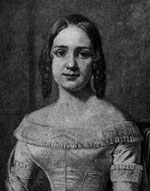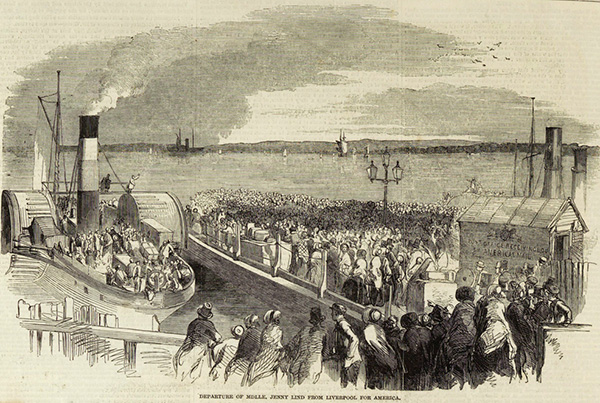Dubbed “The Swedish Nightingale,” Jenny Lind was one of the most famous sopranos in history. She also was an exceptionally shrewd businesswoman.
More than a century before the Beatles mesmerized screaming American audiences and launched the “British invasion” in popular music, another European performer took the country by storm. Jenny Lind, initially famous as a stage star from England and France to her native Sweden, came abroad at the behest of legendary promoter P.T. Barnum.

She did not come cheaply. The terms she demanded were so extravagant they drove Barnum to the brink of bankruptcy and placed his entrepreneurial future at great risk. In the end, however, she more than proved her worth.
The Swedish Nightingale
Born 6 October 1820 in Stockholm, Johanna Maria Lind was gifted with a rare singing voice that came to the attention of operatic performers and instructors when she was a child. At about age 10, she was enrolled at the Royal Theater School in Stockholm, studying voice and drama and performing onstage.
As her soprano voice developed during her teen years, she became a noted attraction with the Royal Swedish Opera. Her professional career proceeded rapidly after her stellar performance in Der Freischütz, a German romantic opera by Carl Maria von Weber, at age 18.
Jenny Lind’s nickname “Swedish Nightingale” was taken from one of Hans Christian Andersen’s fairy tales, “The Nightingale.” Andersen during the early 1840s met and fell in love with her, but she declined to marry him. (Among her other unsuccessful suitors was composer Felix Mendelssohn.)
By the time she was 30, she had emerged as one of Europe’s most popular performers. In America, thanks to an advance blitz of newspaper coverage drummed up by master marketer Barnum, she was destined to become a superstar.
Lind Breaks Barnum’s Bank Accounts
She would tour the United States, Lind told Barnum, only on guaranteed, pricey contractual conditions. She would need full orchestral accompaniment, with a noted conductor and accompanying baritone. She needed a sizeable complement of assistants. She wanted private carriages to transport her around the cities on her tour.
And she demanded $1,000 for each performance.
Barnum accepted the deal, but Lind was skeptical he had the means to meet her terms. As security, he had to come up with $187,500 in advance.
This represented an astounding fortune in 1850. Barnum was able to raise just more than $180,000 and had to borrow the rest.
Barnum’s Gamble Pays Dividends
Barnum was a showman who knew well how to generate newspaper headlines. He promoted Lind not just as a soprano par excellence but as a generous benefactress of worthy causes. All her life, Lind frequently gave free benefit concerts for hospitals, educational facilities, churches and other entities, as well as individuals in need.
At the time, Lind was virtually unknown in the United State. So effectively did Barnum publicize Lind’s arrival in advance, though, that a throng of 40,000 crowded the dock to greet her ship in New York Harbor. People were jostled into the water; several dozen were trampled.
She opened her American tour with a series of concerts, the first of them for charity, at New York City’s Castle Garden in September 1850. From the outset, standing-room-only was the rule. Some enthusiasts paid hundreds of dollars for a ticket.
Reviewers and fans alike agreed she deserved her fee. Performing a variety of music, from folk songs to operatic pieces, she charmed every audience. So enthralling was her voice that the bedazzled orchestra reportedly neglected to play at one of the rehearsals.
New York, Boston, New Orleans, Havana—scores of cities and towns were swept up in the tidal wave of enthusiasm for the young celebrity. In Washington, DC, congress adjourned and many high government officials were in her audience at the National Theater.
Lind’s American tour generated more than $700,000, of which Lind personally earned a quarter of a million. She delivered more than 100 performances during her 20 months in the United States.
A Wealthy Jenny Lind Returns to Europe
Jenny Lind married her accompanist, Otto Goldschmidt, in February 1852 while in the United States. She concluded her American tour at the end of May and returned to Europe. Having achieved unprecedented success and recognition on two continents, she semi-retired from performance.
Her earnings from the United States tour helped provide her with the means establish a music academy in Stockholm. She continued to donate to various causes. She also served for a time as vocal instructor at the Royal College of Music in her native city.
Many people profited from the fame Jenny Lind achieved with her American tour. Barnum recovered his investment several times over. He also began a branding sequence that continues today. A wide array of products and places, from sewing machines to cigars, parks to pubs, have been graced with the “Jenny Lind” label during the past 160 years.
Lind died 2 November 1887.
References:
- The Library of Congress.
- The Jenny Lind Archive, George Mason University.
- Maher, Kathleen. “P.T. Barnum (1810-1891—The Man, the Myth, the Legend.” The Barnum Museum Web Site.
- Sheffel, Richard L., project editor. Customs, Legends, History & Lore of Our Great Nation (Discovering America’s Past). The Reader’s Digest Association, Inc. (1993).








